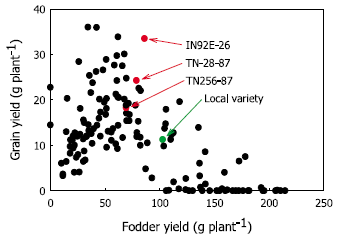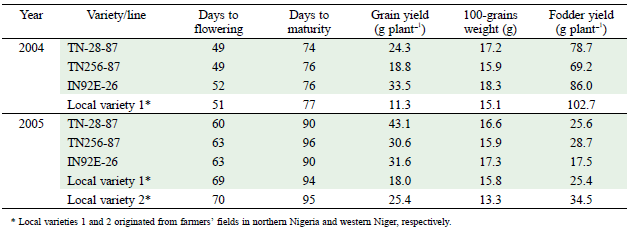Identification of improved dual-purpose cowpea varieties for the Sahel
Description
Cowpea (Vigna unguiculata [L.] Walp.) is one of the most important legumes in West Africa, since it contributes to the traditional crop-livestock system both as grain for human consumption and as residue for animal fodder, particularly in the dry savanna and the Sahel zone. Cowpea can utilize symbiotically fixed nitrogen from the air and take up otherwise insoluble phosphates from the soil, making it also beneficial for companion crops and/or succeeding cereals such as pearl millet and sorghum, the staple food crops in the Sahel. Identification and utilization of genetically improved cowpea varieties with more biomass production (grain and fodder yield), and higher N-fixing and P uptake abilities, would help not only to achieve sustainable productivity but also to maintain soil fertility in the agricultural ecosystems of the Sahel.
A total of 140 cowpea varieties/lines varying in growth habits and phenology, mainly from the IITA (International Institute of Tropical Agriculture) and INRAN (Institute National de la Recherche Agronomique du Niger), were evaluated in an experimental field at the ICRISAT Sahelian Center (N13o14’, E2o16’), Niger, during the rainy season in 2004 and 2005.
The yield of cowpea varieties was considerably affected by their phenology in 2004. Late-flowering varieties, which needed more than 60 days to flowering, produced few grains, while intermediate-flowering varieties, which flowered around 45 to 55 days after sowing, had the highest yield (25 g plant-1 or more). On the other hand, the late-flowering varieties produced a greater fodder yield (100 to 200 g plant-1). No variety with higher yields of both grains and fodder was found, due to a trade-off relationship between grain and fodder production among the varieties used (Fig. 1). Several varieties, however, had intermediate yields of both grains and fodder. These varieties may be adoptable by local farmers on the project site, since around two-thirds preferred varieties with a balanced harvest of both grains and fodder. Three varieties (TN-28-87, TN256-87, and IN92E-26) were finally selected (Fig. 1) after the evaluation of other characteristics, including grain quality and resistance to major biotic stresses. They mostly flowered earlier and had higher grain production with larger grains but lower fodder production than local varieties (Table 1).
Our survey on farmers’ fields on the project site revealed that the planting density of cowpea averaged 2,015 plants ha-1, far lower than the recommended 9,000 plants ha-1. This is thought to be one of the reasons why on-farm yields of cowpea have been much lower than the potential yield and the dissemination of improved cowpea varieties to the farmers has been constrained. The most promising variety, IN92E-26, showed higher grain and fodder yields when planted densely, but a local variety did not (data not shown). For the more efficient utilization of the selected varieties, therefore, more attention should be paid to farm practices such as planting density to obtain the best performance.
Figure, table
-
Fig. 1. Relationship between grain and fodder yield of cowpea varieties/lines in an experimental field at the ICRISAT Sahelian Center in 2004. -
Table 1. Agronomic characteristics of the selected cowpea varieties/lines in an experimental field at the ICRISAT Sahelian Center in 2004 and 2005.
- Affiliation
-
Japan International Research Center for Agricultural Sciences Biological Resources Division
- Classification
-
Technical A
- Term of research
-
FY2003~2006
- Responsible researcher
-
MATSUNAGA Ryoichi ( Crop Production and Environment Division )
SINGH Bir B. ( International Institute of Tropical Agriculture )
ADAMOU Moutari ( Institut National de Recherche Agronomique du Niger )
TOBITA Satoshi ( Crop Production and Environment Division )
HAYASHI Keiichi ( Crop Production and Environment Division )
KAMIDOHZONO Akira ( Crop Production and Environment Division )
- ほか
- Publication, etc.
-
Matsunaga, R., Singh, B. B., Adamou M., Tobita, S., Hayashi, K. and Kamidohzono, A. (2006): Cowpea cultivation in the Sahelian region of West Africa: Farmers’ preferences and production constraints. Japanese Journal of Tropical Agriculture. 50 (4) 208-214
Matsunaga, R., Singh, B. B., Adamou M., Tobita, S., Hayashi, K. and Kamidohzono, A. (2006) Japanese Journal of Tropical Agriculture. 50 (Suppl 1) 77-78.
- Japanese PDF
-
2006_seikajouhou_A4_ja_Part8.pdf545.33 KB


